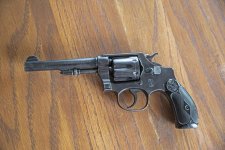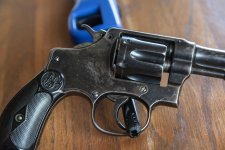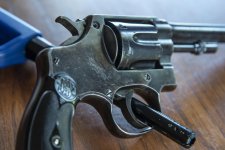I repaired 20mm and 30mm aircraft gatling guns in the Air Force. I've repaired all manner of military surplus rifles. I have my share of slicking and tricking 1911s. I have recently taken the plunge and began tinkering with and trying to make S&W revolvers work a hopefully look a little better. I am a work in progress myself, and am soaking up all the information I can. You guys are a great resource, so I will thank you even before I ask my questions.
I just received this Model 1903 .32 Long Hand Ejector that I purchased from an online auction. I thought I got a pretty decent deal, paying only 2 and a half for it. I noticed in the auction photos that it was missing the sideplate screw, and it appeared that the yoke screw was incorrect. I've sourced those (thanks to you guys). It seems to be in pretty decent shape. My biggest concern was the push up, and it locks on all chambers, so that was a relief. Bore and chambers are great, so this might be a good paper-puncher. I have disassembled it, and inspected, and am pretty pleased. Now to my concerns/questions:
1) I forget the title of the different measurements, but when pushing the empty cylinder forward, the gap between cylinder and forcing cone is .009". When pushing the cylinder to the rear, the gap is .019". That much endplay seems excessive to me, but I'm not familiar with this model, or any model of this vintage. As I will only be firing this gun at paper/tin cans, should I be concerned? If so, is there a somewhat easy fix?
2) When the trigger is pulled and hammer is down, the cylinder seems to have a lot of rotational "wiggle". It seems sloppy. I don't have a way to measure it, but it just isn't as tight as my other newer S&W revolvers. I've read that the cylinders on these old ones were not heat-treated. It appears that the trail-side of the cylinder notches are a bit worn. Is it adviseable to lightly peen the trail-edge only (I know that messing with the lead-edge could lead to all sorts of problems) to tighten this up? Or, is there a better way? Or, am I worried about nothing?
3) And, finally, the question all us novices seem to ask...Serial number is 85829. Can anyone give me an approximate date of manufacture/shipping? I'm just looking for a ballpark.
Thank you!!!!
I just received this Model 1903 .32 Long Hand Ejector that I purchased from an online auction. I thought I got a pretty decent deal, paying only 2 and a half for it. I noticed in the auction photos that it was missing the sideplate screw, and it appeared that the yoke screw was incorrect. I've sourced those (thanks to you guys). It seems to be in pretty decent shape. My biggest concern was the push up, and it locks on all chambers, so that was a relief. Bore and chambers are great, so this might be a good paper-puncher. I have disassembled it, and inspected, and am pretty pleased. Now to my concerns/questions:
1) I forget the title of the different measurements, but when pushing the empty cylinder forward, the gap between cylinder and forcing cone is .009". When pushing the cylinder to the rear, the gap is .019". That much endplay seems excessive to me, but I'm not familiar with this model, or any model of this vintage. As I will only be firing this gun at paper/tin cans, should I be concerned? If so, is there a somewhat easy fix?
2) When the trigger is pulled and hammer is down, the cylinder seems to have a lot of rotational "wiggle". It seems sloppy. I don't have a way to measure it, but it just isn't as tight as my other newer S&W revolvers. I've read that the cylinders on these old ones were not heat-treated. It appears that the trail-side of the cylinder notches are a bit worn. Is it adviseable to lightly peen the trail-edge only (I know that messing with the lead-edge could lead to all sorts of problems) to tighten this up? Or, is there a better way? Or, am I worried about nothing?
3) And, finally, the question all us novices seem to ask...Serial number is 85829. Can anyone give me an approximate date of manufacture/shipping? I'm just looking for a ballpark.
Thank you!!!!



